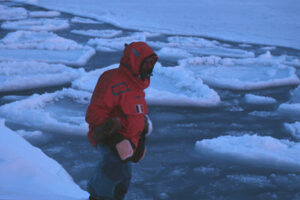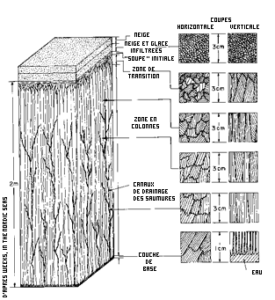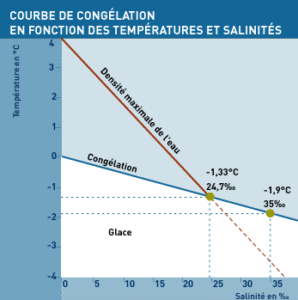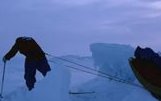
CONTENTS
OCEAN AND MARINE LIFE
- THE ARCTIC OCEAN AND THE OCEAN CURRENTS
- GENESIS OF THE ARCTIC OCEAN
- ARCTIC PLANKTON
- MARINE BIODIVERSITY AND FOOD WEB
- WHALES AND OTHER CETACEANS
- SEALS AND WALRUSES
TERRESTRIAL LIFE
- POLAR FLORA
- POLAR FAUNA
- THE POLAR BEAR
- ARCTIC BIRDS
- SPECIES EVOLUTION AND CLIMATE
HISTORY AND GEOGRAPHY
- GEOGRAPHY OF THE ARCTIC REGIONS
- GEOGRAPHIC NORTH POLE, MAGNETIC NORTH POLE
- WHO OWNS THE ARCTIC?
- THE EXPLORERS OF THE FAR NORTH
- THE INUIT
- OTHER PEOPLES OF THE FAR NORTH
- THE ARCTIC TODAY

A LAYER OF ICE ON THE SEA SURFACE
At the end of summer, the polar cold sets in, sometimes abruptly (–40°C); the ocean surface cools. When it reaches –1.8°C, the first ice crystals form. Once the surface is frozen, the seawater is isolated from the cold air and the process slows down. The sea ice then slowly thickens from its underside, reaching approximately 2 meters.
FRESH OR SALTY?
As it freezes, seawater forms an interweaving of freshwater ice crystals and brine droplets. During winter, these salty droplets cluster together, forming wider networks, then pockets, and migrate downwards before being expelled into the sea. Thus, as it ages, the sea ice freshens.


THE LIFE OF SEA ICE
In the heart of winter, sea ice extends over nearly 15 million km², of which almost half will melt during the summer. The remaining portion will persist for 2, 3, 4 years or more, and its thickness will then reach 4 to 5 meters. During this time, this ice crust will traverse the Arctic Ocean, carried by currents: this is the Arctic drift.
A CHAOTIC RAFT
Sea ice is merely a thin eggshell compared to the 4000 meters of water on which it floats! Carried by currents, harassed by winds, it constantly breaks, opens, and overlaps, creating, here, open water channels, and there, ice ridges whose crests can reach ten meters in height.


THE ONSET OF FREEZING
The nature of the first ice depends on the state of the sea. In calm weather, large needle-shaped crystals align parallel to each other and form a 1 to 2 cm thick layer on the surface (an icy ‘soup’). If the sea is rough, small crystals develop in all directions, sometimes up to a meter deep, forming a thick viscous layer: frazil ice. Only then does freezing begin on the surface. This freezing process can last from 9 to 36 days.
WHEN THE ICE THICKENS
As long as the ice is thin, swell and winds fragment it into ‘pancakes,’ which eventually fuse together to form young sea ice, then capable of retaining snow. It takes several weeks for the ice to reach 60 cm in thickness. By slowly expelling air bubbles and brine, the ice compacts, freshens, and becomes blue and translucent.

The Antarctica caught in the ice off Spitsbergen. © F. Latreille/7th Continent
AT THE HEART OF THE ICE
In the Arctic, sea surface salinity varies from 32 to 33 g/L (compared to an average of 35 for the global ocean). The first ice crystals form small lamellae 1 millimeter thick, and tiny brine droplets (about ten micrometers) are trapped within this crystalline network. Young sea ice thus traps up to 22 g/L of salts. Seawater also contains impurities and air bubbles, which are also trapped in the ice.

CONSTANT AGITATION
Under the influence of winds, currents, and tides, sea ice constantly fragments and reforms. Here, open water channels open up, as do sorts of inland lakes (polynyas) due to local upwellings of less cold water. There, fissures close.
Collisions between fragments create compressed ice ridges, whose crests can reach 10 meters and keels can extend up to sixty meters deep!
Near the coasts, sea ice is also shaped by tides, freshwater inputs, coastal currents, and exposure to wind or sun. A grounded ice foot, resting on the seabed, remains attached to the coast. This ‘shore ice’ can be thicker than the sea ice itself and anchor to the seabed; offshore, it extends as a band of ‘fast ice’ (in English fast ice), which can survive for more than 10 years. Sometimes, trapped icebergs are found there.
WHEN MELTING OCCURS
At the end of May, snow and the first centimeters of ice melt, forming melt ponds on the sea ice surface. This water reflects less solar energy than bare ice and warms up faster, locally accelerating the melt. When the sea ice fractures, large sections break free (floes) and then drift with the currents. This is the breakup. In the center of the Arctic Ocean and along sheltered coasts, the sea ice will not thaw.
THE GRAND BALLET OF THE ARCTIC DRIFT
The icy puzzle of the Arctic Ocean follows, over the months, the general movement of the waters that carry it. This is the Arctic drift.
The Arctic drift was discovered thanks to the debris from the wreck of La Jeannette (1881), found 3 years later thousands of kilometers from the shipwreck site. Nansen with the Fram in 1893-1896 and Papanin in 1937 utilized this drift.
STUDYING SEA ICE
Channels, compression ridges, ice of varying salinity and age, seasonal pulsation, drift: the entire life of the sea ice is monitored by scientists using drifting stations installed on the ice, beacons, and satellites.
NAVIGATING SEA ICE
THE PHYSICISTS’ CORNER
VOCABULARY

Jean-Louis Etienne pulling his sled on the sea ice during his solo walk to the Pole in 1986. © B. Prudhomme


